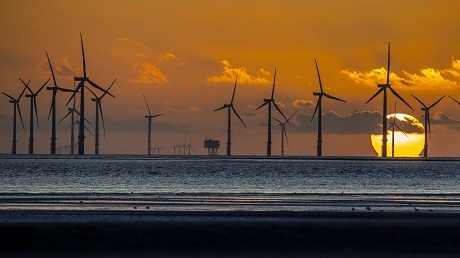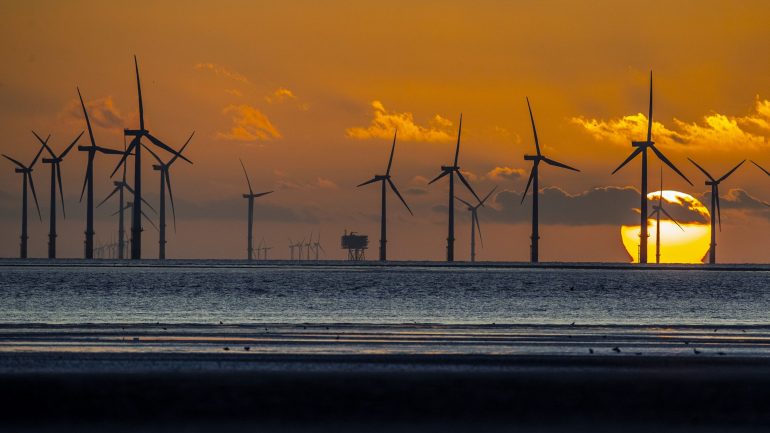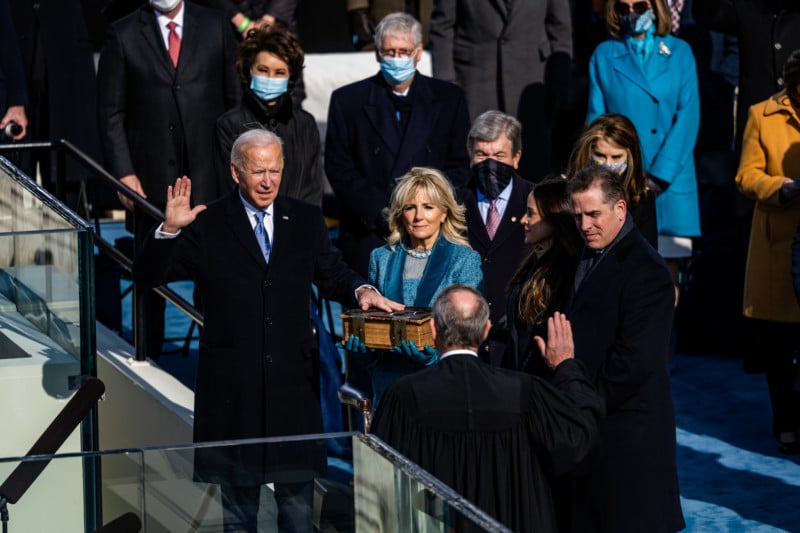

On January 20th, 2021, I stood on the press risers at the Presidential Inauguration in Washington, DC, photographing Joe Biden taking the oath of office. It had already been a busy and chaotic month. Two weeks prior, I’d stood on these same press risers making photos as tear gas clouded the air and violent insurrectionists broke through overwhelmed police lines to gain entrance to the Capitol. The dissonance between these two events was head-spinning.
When Senator Joe Biden won the election, I proposed a photo essay to Politico to document the first 100 days of the new administration and its effect on the city. I had previously done a similar story for them four years earlier that had run over 22 pages in Politico Magazine and online. They accepted the proposal and soon had put together an amazing team of designers, coders, and producers who would build the site for this story, integrating the photos, videos and audio I would capture over the next three-plus months.
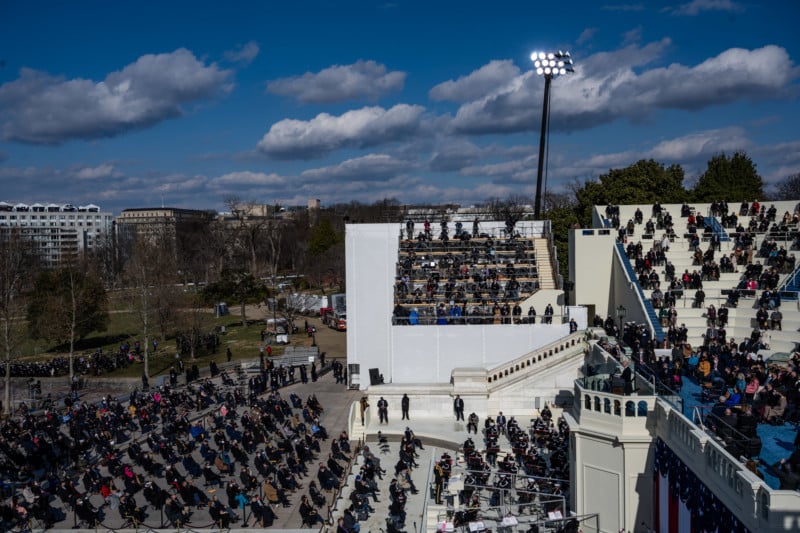 Day 1: President Joseph R. Biden speaks at the 59th presidential inauguration in Washington, DC, on Wednesday, January 20, 2021 after being sworn in as President.
Day 1: President Joseph R. Biden speaks at the 59th presidential inauguration in Washington, DC, on Wednesday, January 20, 2021 after being sworn in as President.
The structure of this project meant that each day was a new opportunity, a requirement really, to make a photo. I kept a running ideas document that I was constantly editing with the help of my photo editor at Politico. I closely watched a Twitter list I’d put together to find out about spontaneous protests, gatherings, and other opportunities. Every ten days, I’d put together an edit of what I’d photographed so far and send it over to my editor. This allowed us to work together to identify gaps in the story and be more intentional about telling a wide range of stories.
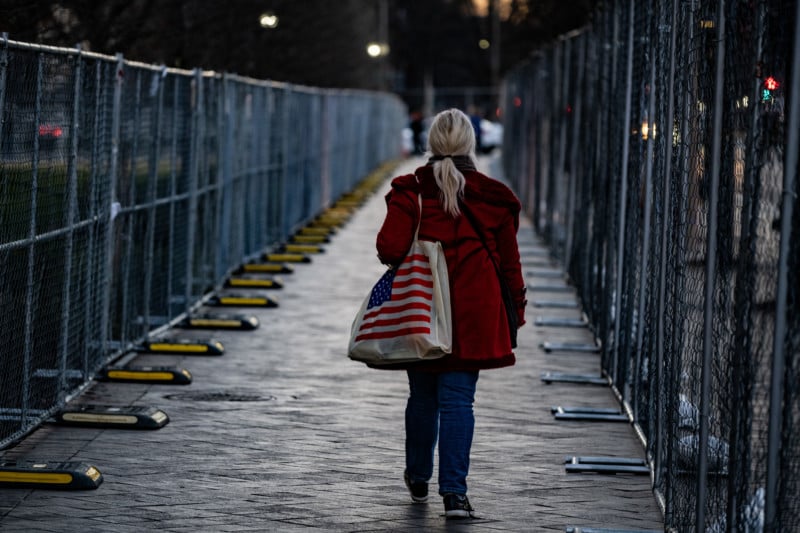 Day 2: A woman navigates the fencing setup for the Presidential Inauguration in parts of downtown Washington, DC, on the day after the Inauguration, on January 21, 2021.
Day 2: A woman navigates the fencing setup for the Presidential Inauguration in parts of downtown Washington, DC, on the day after the Inauguration, on January 21, 2021.
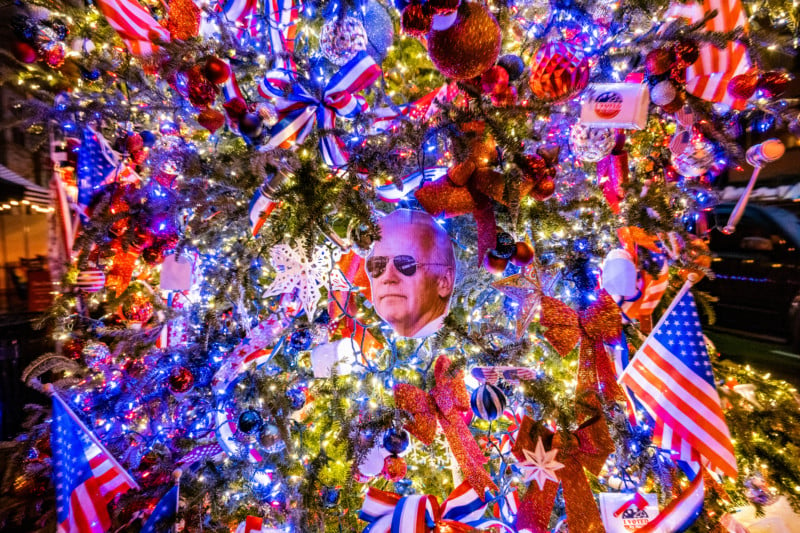
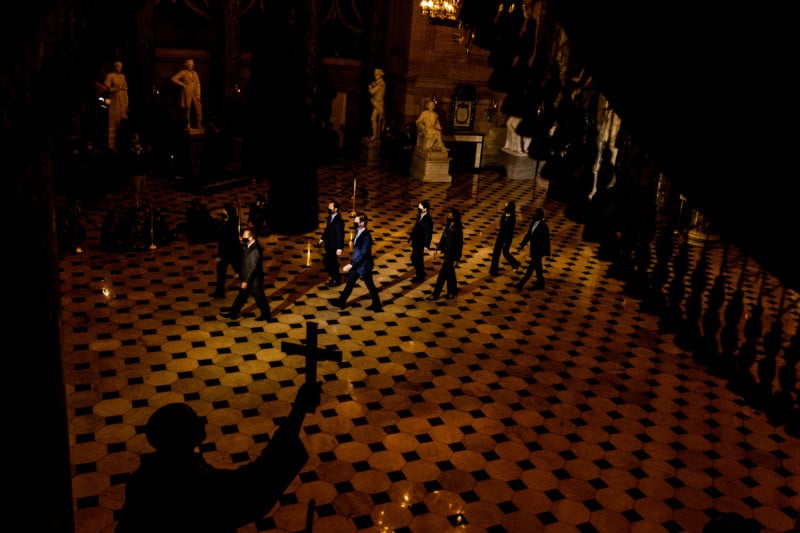 Day 6: House managers walk the article of impeachment against President Donald Trump through Statuary Hall to the Senate Chamber in Washington, DC, January 25, 2021.
Day 6: House managers walk the article of impeachment against President Donald Trump through Statuary Hall to the Senate Chamber in Washington, DC, January 25, 2021.
On day seven, I walked around the Capitol complex, which was completely fenced off from the public. A storm had come in overnight, covering the grass in wet, bone-chilling snow. The National Guard stationed around the Capitol worked twelve-hour shifts, standing guard through long, cold nights. They had been hastily called up, leaving behind school, jobs, and families, with little indication as to how long they’d be there for.
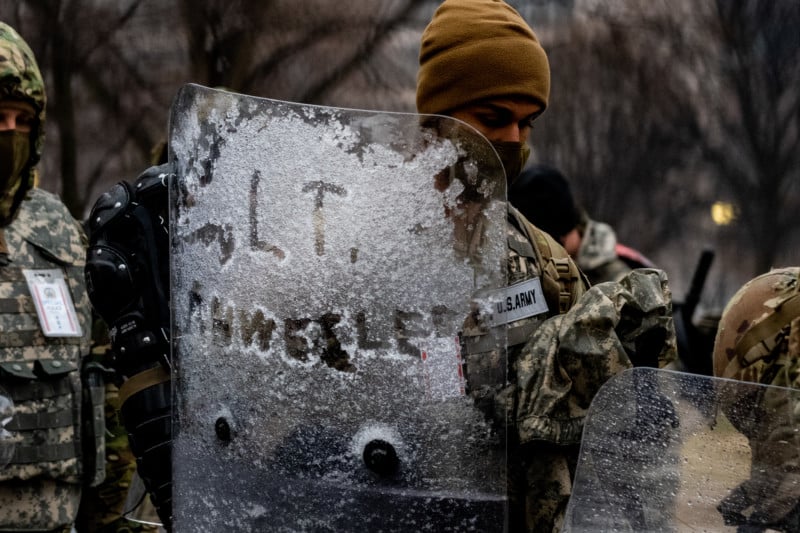 Day 7: National Guardsmen stationed around the US Capitol grounds in Washington, DC, January 26, 2021. Today, it was announced that the National Guard would remain in Washington, DC in sizable numbers until at least March, 2021.
Day 7: National Guardsmen stationed around the US Capitol grounds in Washington, DC, January 26, 2021. Today, it was announced that the National Guard would remain in Washington, DC in sizable numbers until at least March, 2021.
On day 12, following a tip, I photographed an underground parking garage at a prominent private school in the city that had been converted into a large, outdoor classroom. By that time, my own kids had been attending school virtually for nearly a year and it was striking to see how private schools had managed to resume in-person, which was still months away from happening for public schools.
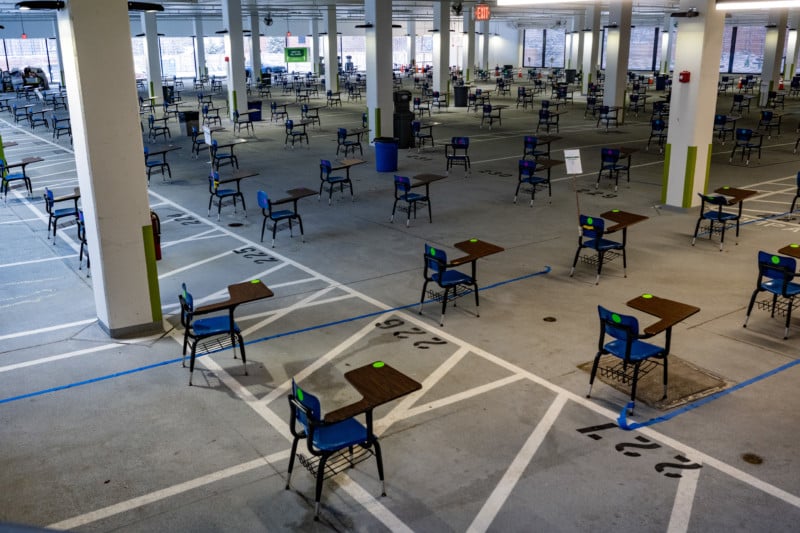 Day 12: An outdoor learning space set up in a parking garage at Georgetown Day School, a private school in Washington, DC, January 31, 2021. Public schools in the city have largely been closed or only accepting a fraction of their usual in-person students. DC public schools are scheduled to reopen on a limited basis on Thursday while the rest of the student population will continue to learn virtually.
Day 12: An outdoor learning space set up in a parking garage at Georgetown Day School, a private school in Washington, DC, January 31, 2021. Public schools in the city have largely been closed or only accepting a fraction of their usual in-person students. DC public schools are scheduled to reopen on a limited basis on Thursday while the rest of the student population will continue to learn virtually.
Day 18 was a month to the day after the insurrection. Unseasonably warm weather brought throngs of people to the National Mall. Children played on picnic blankets, just feet away from the looming metal and concrete barriers that protected the Capitol. People stopped to take selfies by the fence, framing the photos to get the armed National Guardsmen over their shoulder in the shots, standing in silence.
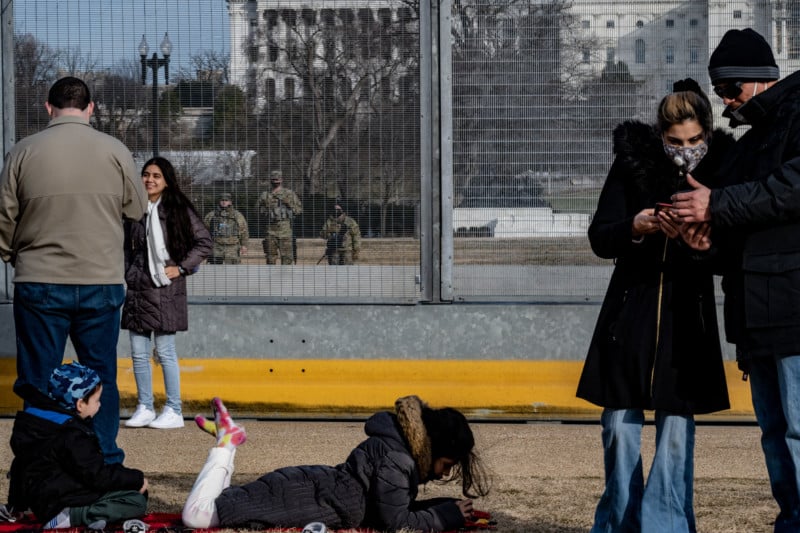 Day 18: One month ago, insurrectionists stormed the US Capitol leading to the death of a Capitol Police officer. Today, a family picnics on the National Mall near a fence with National Guardsmen on the other side, in Washington, DC on February 6, 2021.
Day 18: One month ago, insurrectionists stormed the US Capitol leading to the death of a Capitol Police officer. Today, a family picnics on the National Mall near a fence with National Guardsmen on the other side, in Washington, DC on February 6, 2021. 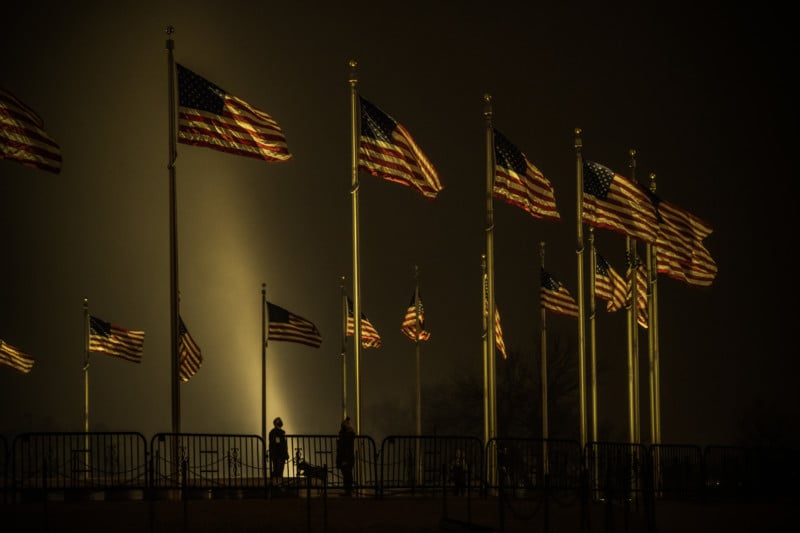 Day 27: A foggy, rainy night at the Washington Monument in Washington, DC on February 15, 2021.
Day 27: A foggy, rainy night at the Washington Monument in Washington, DC on February 15, 2021. 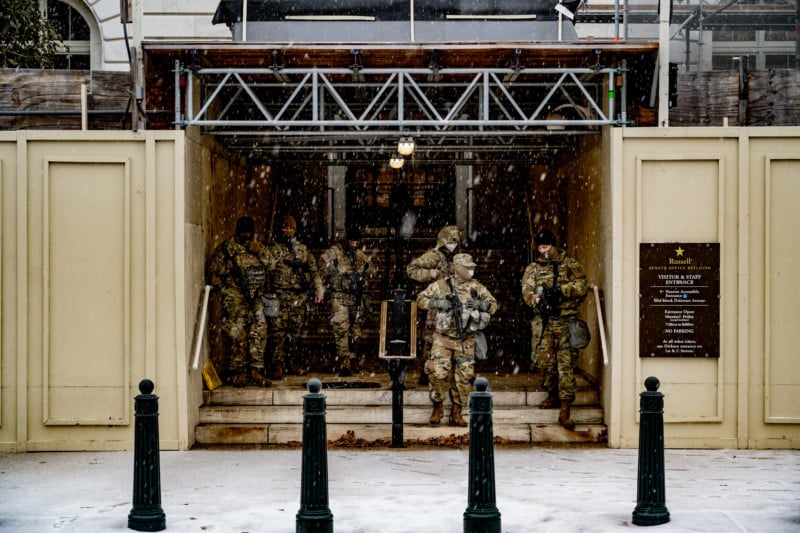 Day 30: National Guardsmen shelter under an overhang at the Russell Senate Office Building during a snowstorm in Washington, DC on February 18, 2021.
Day 30: National Guardsmen shelter under an overhang at the Russell Senate Office Building during a snowstorm in Washington, DC on February 18, 2021.
I remember day 31 feeling like one of the coldest days of the winter. President Biden had made his first official Presidential trip to a Pfizer plant in Kalamazoo, Michigan and I wanted to photograph him returning to the White House. I was familiar with the typical path that Marine One took and positioned myself on the National Mall, near the Washington Monument. The winter light was fading quickly as I stand in wet grass, waiting. At last, I heard a distance thump-thump of the helicopters, then watched Marine One fly past the Washington Monument to land on the south lawn of the White House.
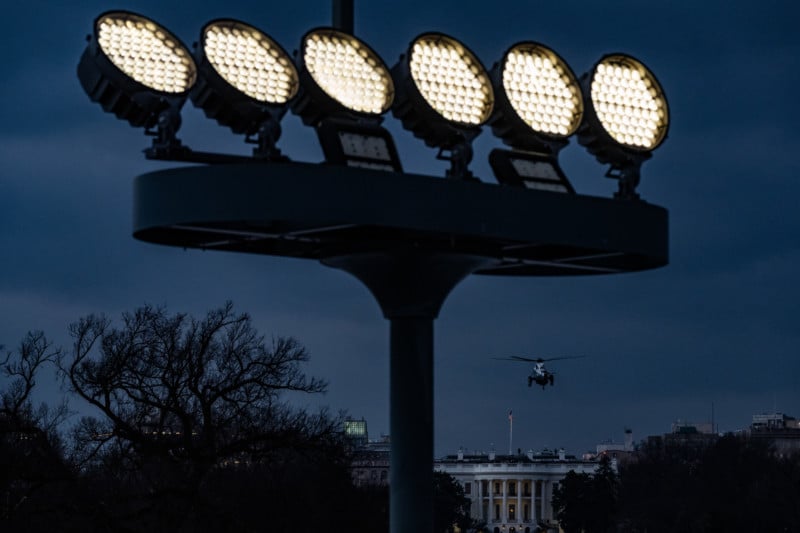 Day 31: Marine One flies back to the White House after President Joe Biden’s trip to Kalamazoo, Michigan to visit a Pfizer COVID-19 production facility, in Washington, DC, on February 19, 2021. The trip to Kalamazoo was one of the President’s first official trips of his presidency.
Day 31: Marine One flies back to the White House after President Joe Biden’s trip to Kalamazoo, Michigan to visit a Pfizer COVID-19 production facility, in Washington, DC, on February 19, 2021. The trip to Kalamazoo was one of the President’s first official trips of his presidency. 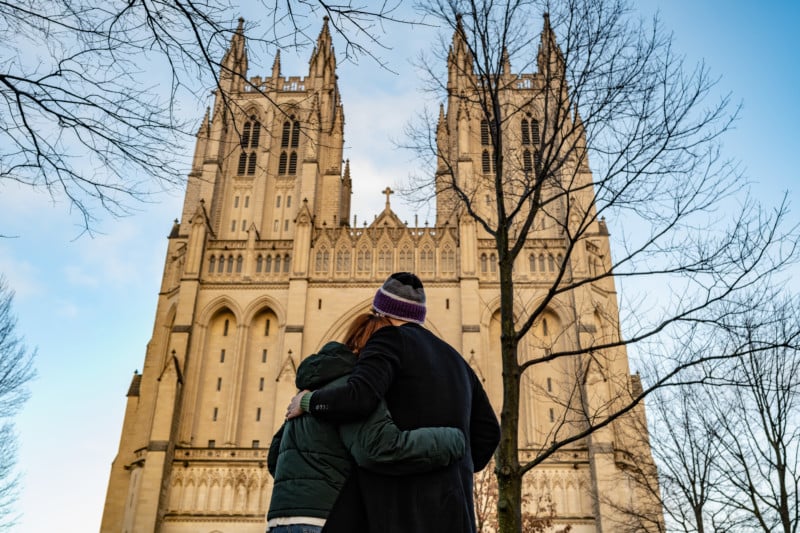 Day 34: Onlookers listen as the bells at the National Cathedral in Washington, DC, are rung 500 times to memorialize the more than 500,000 people who have died from the coronavirus in the United States.
Day 34: Onlookers listen as the bells at the National Cathedral in Washington, DC, are rung 500 times to memorialize the more than 500,000 people who have died from the coronavirus in the United States. 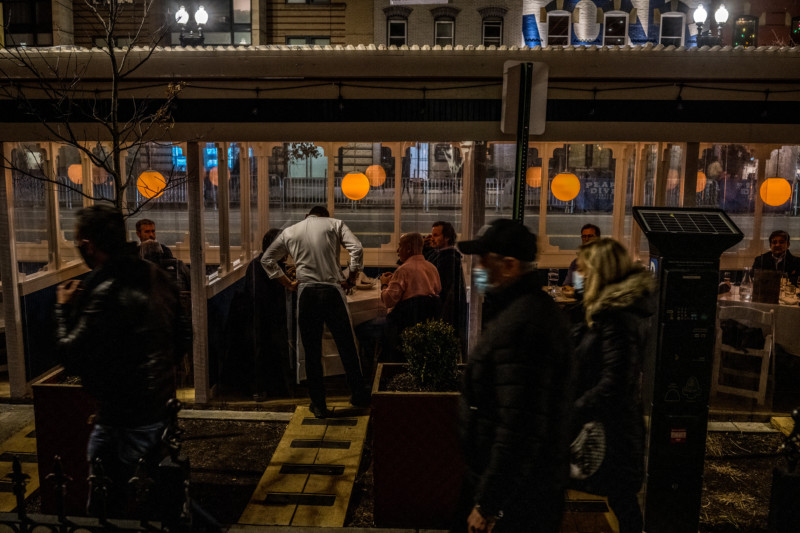 Day 36: People dine outdoors at Le Diplomate, a restaurant in the Logan Circle neighborhood of Washington, DC, on February 24, 2021. As of December, restaurants in the city were limited to indoor dining at 25% of their capacity.
Day 36: People dine outdoors at Le Diplomate, a restaurant in the Logan Circle neighborhood of Washington, DC, on February 24, 2021. As of December, restaurants in the city were limited to indoor dining at 25% of their capacity. 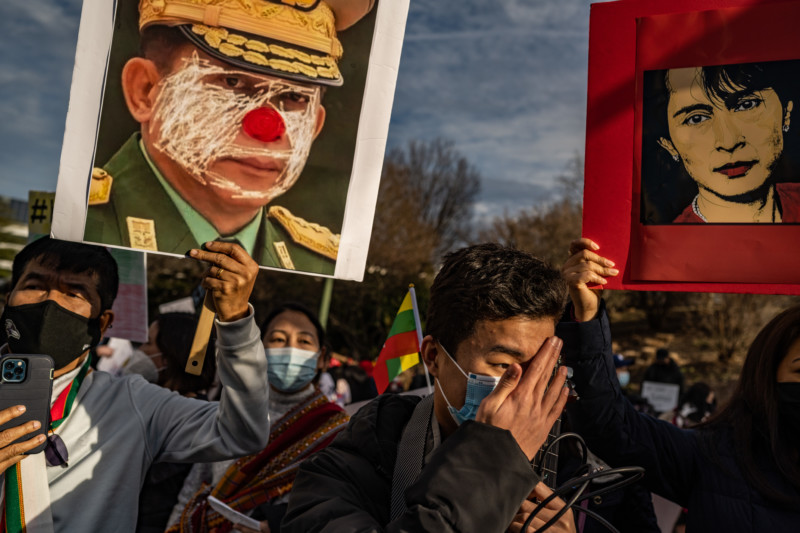 Day 39: Pro-democracy protesters march to the Chinese embassy in Washington, DC, on February 27, 2021, in support of ousted Myanmar leader Aung San Suu Kyi. The State councilor was arrested by the military during a Coup d'état. Protesters blamed the Chinese government for its support of the Burmese military.
Day 39: Pro-democracy protesters march to the Chinese embassy in Washington, DC, on February 27, 2021, in support of ousted Myanmar leader Aung San Suu Kyi. The State councilor was arrested by the military during a Coup d'état. Protesters blamed the Chinese government for its support of the Burmese military. 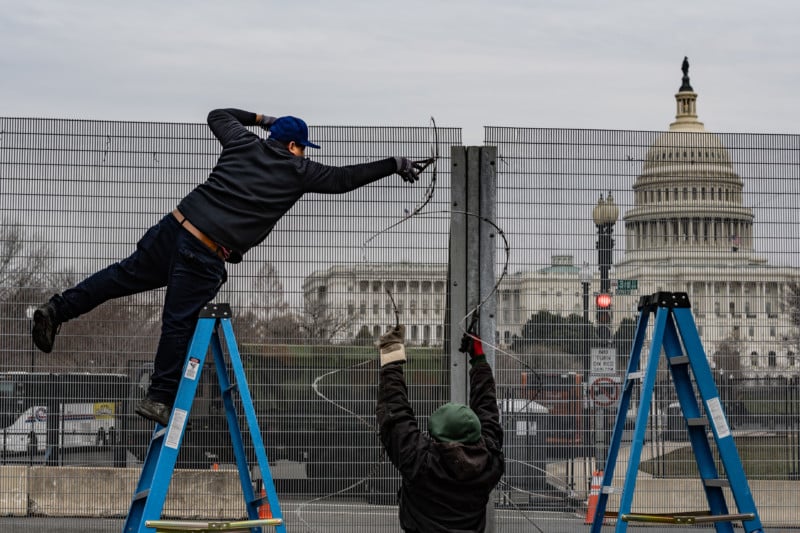 Day 41: Workers remove the concertina razor wire from the tops of the fences surrounding the US Capitol complex in Washington, DC, on March 1, 2021. Despite enormous pushback, the fencing is slated to be replaced and the razor wire reinstalled.
Day 41: Workers remove the concertina razor wire from the tops of the fences surrounding the US Capitol complex in Washington, DC, on March 1, 2021. Despite enormous pushback, the fencing is slated to be replaced and the razor wire reinstalled. 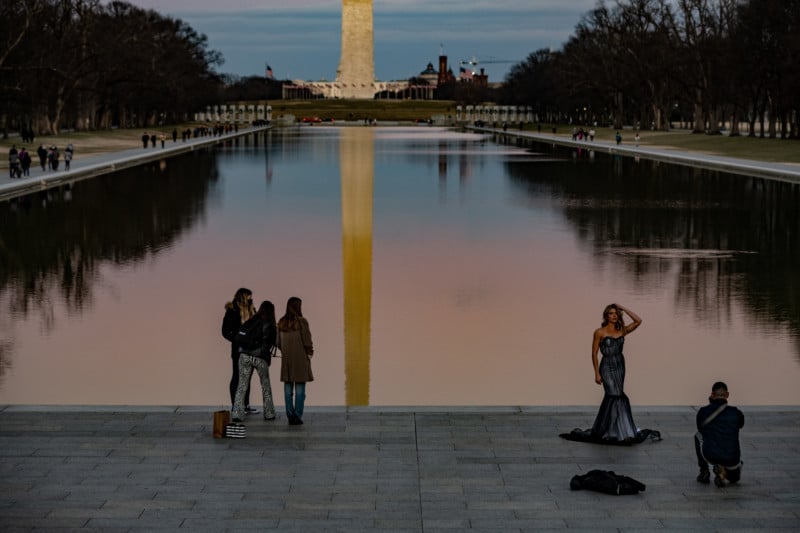 Day 46: A woman poses for photos near the Reflecting Pool at sunset in Washington, DC, on March 6, 2021. Today, the US Senate passed the $1.9 trillion dollar American Rescue Plan on party lines.
Day 46: A woman poses for photos near the Reflecting Pool at sunset in Washington, DC, on March 6, 2021. Today, the US Senate passed the $1.9 trillion dollar American Rescue Plan on party lines. 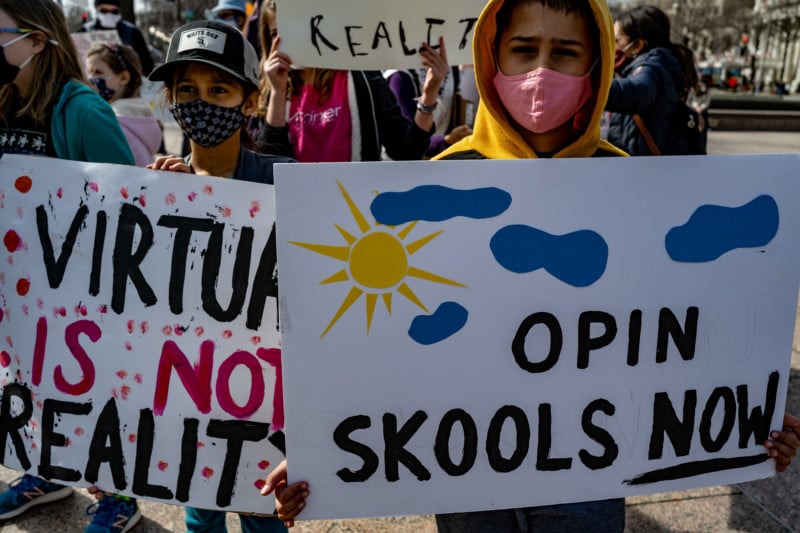 Day 53: Parents and students of DC public schools gather at Freedom Plaza to urge Mayor Muriel Bowser to reopen schools, on May 13, 2021. While some DC schools have reopened, they have only accepted limited numbers of students due to an agreement made with the Washington Teachers Union.
Day 53: Parents and students of DC public schools gather at Freedom Plaza to urge Mayor Muriel Bowser to reopen schools, on May 13, 2021. While some DC schools have reopened, they have only accepted limited numbers of students due to an agreement made with the Washington Teachers Union. 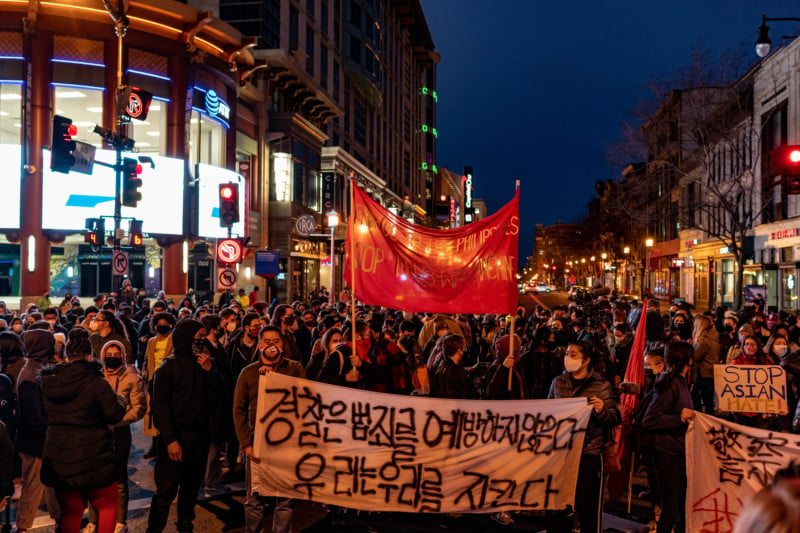 Day 57: Activists participate in a vigil in response to the Atlanta shootings that appear to have targeted Asian Americans. Activists gathered near the Friendship Archway in the Chinatown neighborhood of Washington, DC, on March 17, 2021.
Day 57: Activists participate in a vigil in response to the Atlanta shootings that appear to have targeted Asian Americans. Activists gathered near the Friendship Archway in the Chinatown neighborhood of Washington, DC, on March 17, 2021. 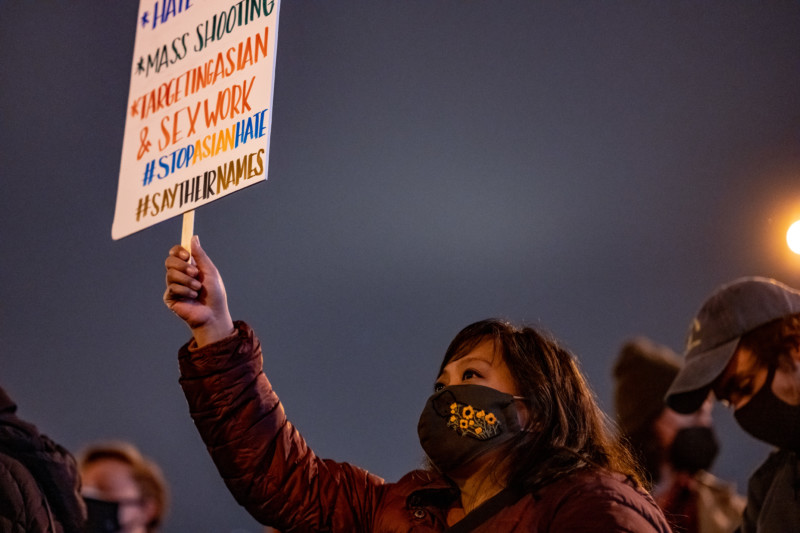 Day 57: Activists participate in a vigil in response to the Atlanta shootings that appear to have targeted Asian Americans. Activists gathered near the Friendship Archway in the Chinatown neighborhood of Washington, DC, on March 17, 2021.
Day 57: Activists participate in a vigil in response to the Atlanta shootings that appear to have targeted Asian Americans. Activists gathered near the Friendship Archway in the Chinatown neighborhood of Washington, DC, on March 17, 2021.  Day 58: This past year has been incredibly hard on businesses in the city. Otello Osteria in the Dupont Circle neighborhood closed this past September after thirty-five years of business.
Day 58: This past year has been incredibly hard on businesses in the city. Otello Osteria in the Dupont Circle neighborhood closed this past September after thirty-five years of business. 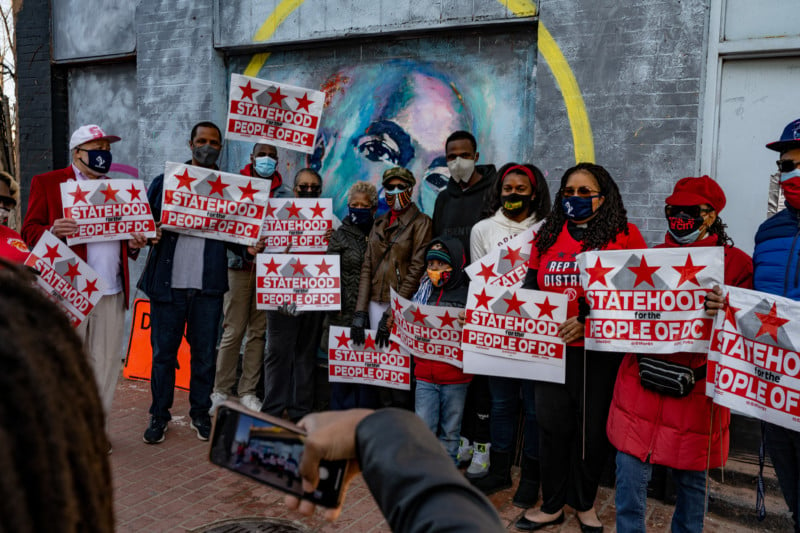 Day 62: DC Statehood activists stage a protest in the Anacostia neighborhood of Washington, DC, on March 22, 2021. Later in the day, Mayor Muriel Bowser will testify in support of HR 51 which would make DC a state. The bill passed the House in 2009 and looks unlikely to be voted on in the Senate.
Day 62: DC Statehood activists stage a protest in the Anacostia neighborhood of Washington, DC, on March 22, 2021. Later in the day, Mayor Muriel Bowser will testify in support of HR 51 which would make DC a state. The bill passed the House in 2009 and looks unlikely to be voted on in the Senate. 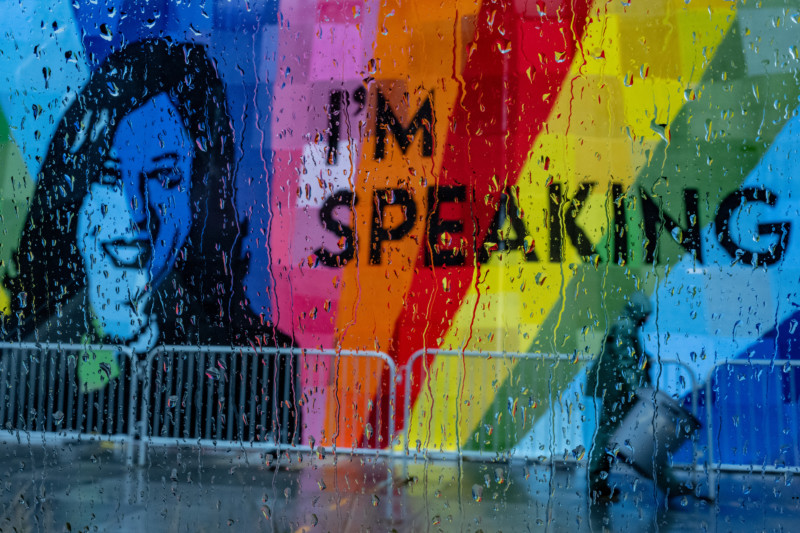 Day 64: A knit mural of Vice President Kamala Harris is displayed near The Wharf. Artist London Kaye worked with 150 people across the country to crochet squares for the mural which were then combined.
Day 64: A knit mural of Vice President Kamala Harris is displayed near The Wharf. Artist London Kaye worked with 150 people across the country to crochet squares for the mural which were then combined. 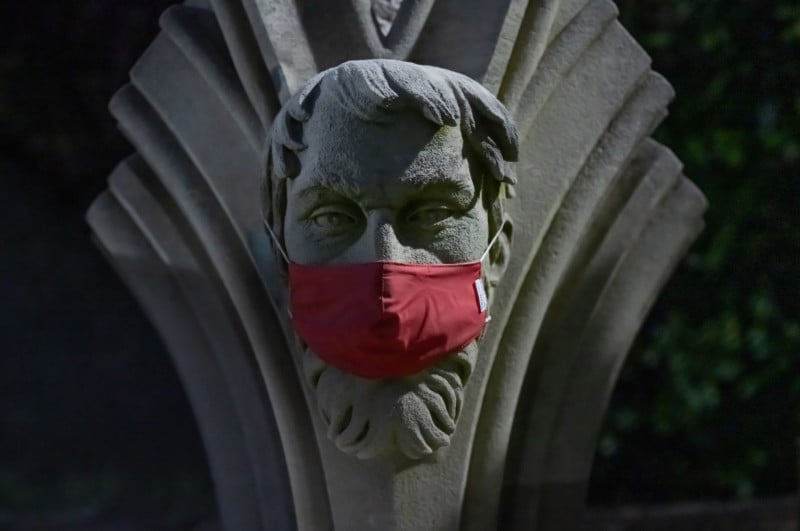 Day 67: Statues are adorned with facemarks at the National Cathedral in Washington, DC.
Day 67: Statues are adorned with facemarks at the National Cathedral in Washington, DC.
Late March brought the arrival of the cherry blossoms, always a beautiful and picturesque time to be in the city. The normalcy of watching people walk under the pinkish-white canopy of flowers as the days grew longer had me hopeful that we’d seen the worst of the pandemic already pass.
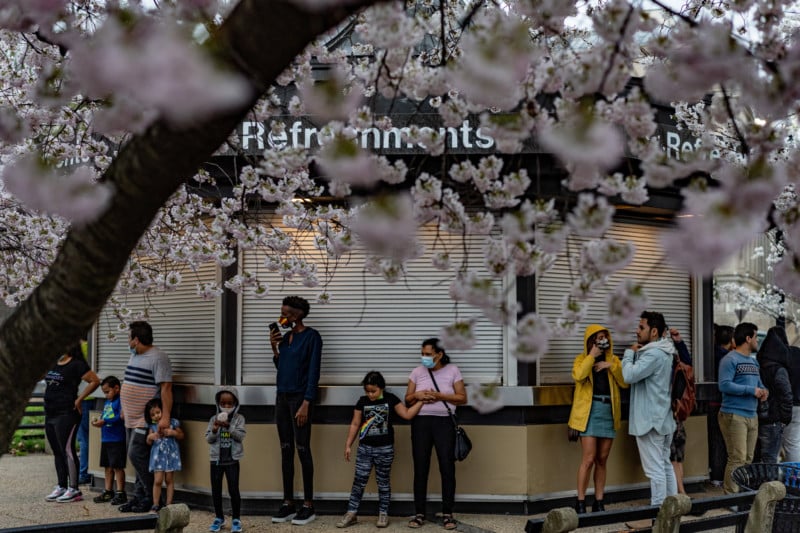 Day 68: Visitors take shelter from an approaching storm along the Tidal Basin with the cherry blossoms trees approaching full bloom. NPS warned about the possibility of closing down the area if people were not maintaining social distance but as of today, have not yet taken action.
Day 68: Visitors take shelter from an approaching storm along the Tidal Basin with the cherry blossoms trees approaching full bloom. NPS warned about the possibility of closing down the area if people were not maintaining social distance but as of today, have not yet taken action.
For a brief aside on equipment -- midway through the project (day 64 to be exact) I switched to Sony gear from Nikon. I’d been using Nikon DSLRs for years, shooting magazine covers, the BLM protests last summer, and many, many portraits.
I’ve been closely watching the progress of mirrorless cameras for years, noticing as more and more of my colleagues in DC make the switch. A few years back, I began using a Leica Q, an absolute gem of a camera that happened to be mirrorless. The experience taught me that my concerns about EVFs feeling laggy or not high-resolution enough were overstated and that it was time to embrace our pixel-ly viewfinder future. In January 2021, I took delivery of a couple of Nikon Z7 IIs. The cameras went into regular rotation.
My initial impressions of the Nikons were pretty mixed. It was a camera that felt slow overall -- slow turning on, slow focusing in low light, and slow switching from LCD to EVF.
I found myself casting about a little, unsure if I had made a good choice. When the Sony Alpha 1 was announced, it piqued my interest and I immediately pre-ordered one, receiving the first body in mid-March. The Sony Alpha 1 is the everything camera, a photographic tool with specs that seem tuned to conquer its competitors in a side-by-side comparison. The in-house CMOS chip production and an aggressive lens roadmap also drew me in.
For a few weeks, I shot the two cameras side by side, thousands of frames on each, and developed some strong feelings about how they were laid out. Generally speaking, I dislike the prominent positioning of the custom buttons on the Sony and prefer the way Nikon made more definitive choices about where important buttons should go (specifically the Playback and ISO buttons) which seem more logically placed. That said, the responsiveness of the Alpha 1 makes me never feel like I’m waiting on the camera to do something like I did with the Nikons. As a side note, I’m sure that the Nikon Z9 coming down the pipe will solve a lot of these issues but will also presumably weigh more which is a drawback for me.
The rest of the project was photographed with the Sony Alpha 1 and three lenses -- the Sony 35mm/1.4 GM, Sony 55mm/1.8 Sonnar, and Sony 70-200mm f/4.
As the weather warmed, I was able to photograph opening day at the Nationals stadium. Strict limits on press coverage meant I wasn’t able to get inside, but I found a nearby parking garage that gave me a good view of the field and nearly empty stands.
On April 2nd, day 73 of the project, tragedy once again struck the Capitol as a police officer was killed when a car crashed into a barricade. I felt tremendous empathy for the Capitol Police officers who were called to defend the Capitol, knowing they had once again lost one of their own.
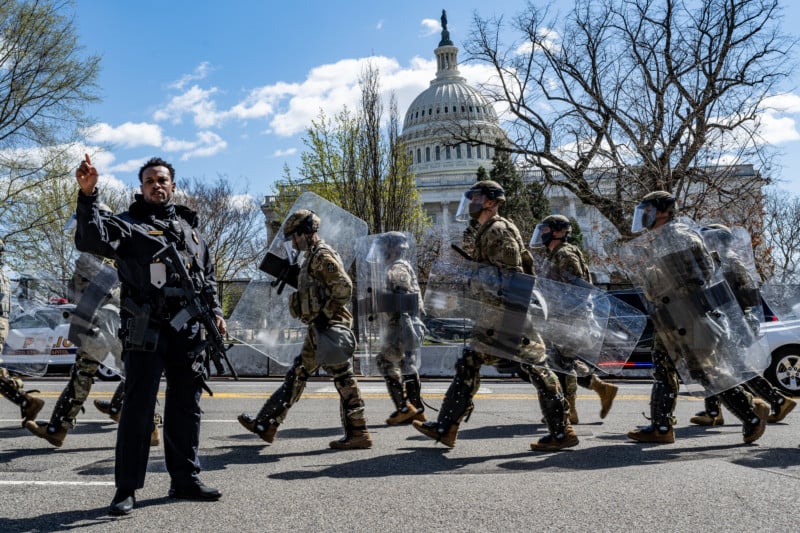 Day 73: A US Capitol Police officer motions for the media to stay back as a group of National Guardsmen holding shields walk past him, during a lockdown after a car crashed into one of the permanent barricades surrounding the complex. Capitol Police officer William Evans was killed in the attack and another officer was injured. The assailant, Noah R. Green, was shot and killed by officers after emerging from the car holding a knife and threatening the officers.
Day 73: A US Capitol Police officer motions for the media to stay back as a group of National Guardsmen holding shields walk past him, during a lockdown after a car crashed into one of the permanent barricades surrounding the complex. Capitol Police officer William Evans was killed in the attack and another officer was injured. The assailant, Noah R. Green, was shot and killed by officers after emerging from the car holding a knife and threatening the officers. 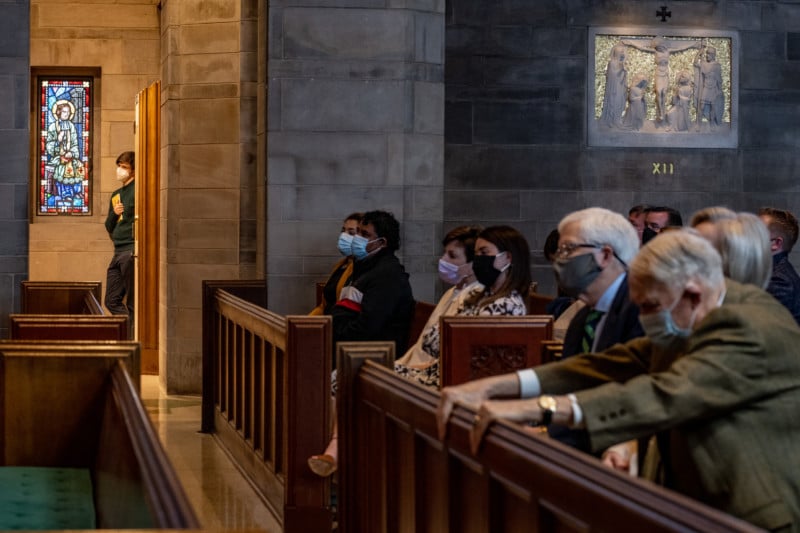 Day 75: An Easter Sunday service is held at St. Ann Roman Catholic Church, in Washington, DC. The church had previously implemented a reservation system for parishioners to attend services, but on this day, allowed anyone to come, but using an overflow room to help with social distancing.
Day 75: An Easter Sunday service is held at St. Ann Roman Catholic Church, in Washington, DC. The church had previously implemented a reservation system for parishioners to attend services, but on this day, allowed anyone to come, but using an overflow room to help with social distancing. 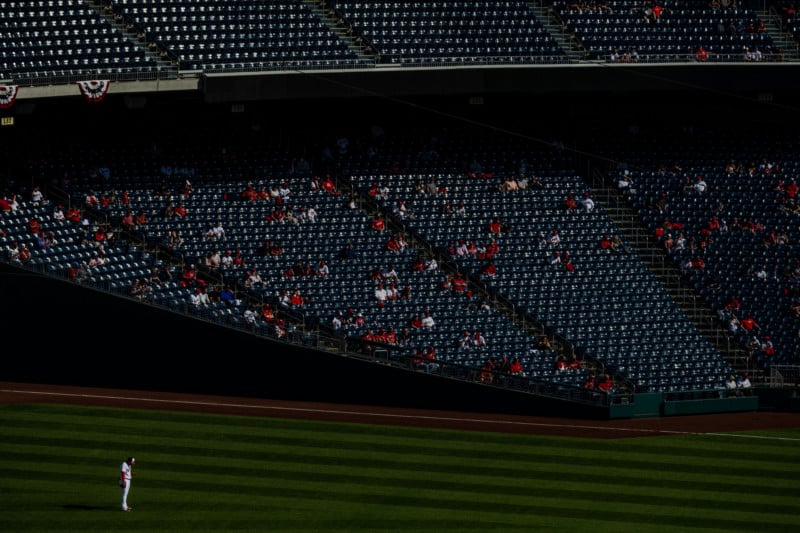 Day 77: The Washington Nationals play the Atlanta Braves on opening day of their season. The start of the Nationals season was delayed after some players tested positive for the coronavirus. 5,000 fans were allowed to attend the game.
Day 77: The Washington Nationals play the Atlanta Braves on opening day of their season. The start of the Nationals season was delayed after some players tested positive for the coronavirus. 5,000 fans were allowed to attend the game.
The Nationals won the game against the Atlanta Braves in the bottom of the 9th as Juan Soto drove in the winning run to put the team ahead 6-5. 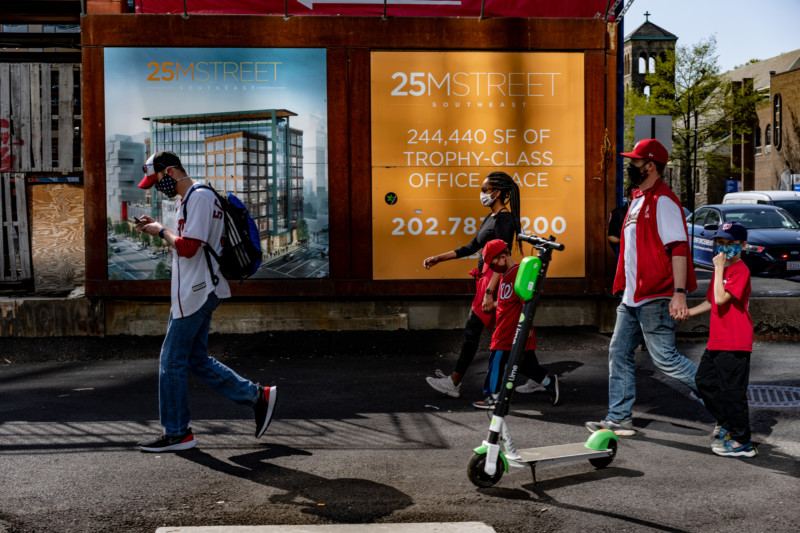 Day 77: Fans walk to Nationals Park to watch the Nationals on opening day of their season. The start of the Nationals season was delayed after some players tested positive for the coronavirus.
Day 77: Fans walk to Nationals Park to watch the Nationals on opening day of their season. The start of the Nationals season was delayed after some players tested positive for the coronavirus.
The Nationals won the game against the Atlanta Braves in the bottom of the 9th as Juan Soto drove in the winning run to put the team ahead 6-5.
On day 83, I saw a post on Facebook that led me to a backyard concert for an audience of no one. These musician neighbors had gotten together every once in a while throughout the pandemic to play music together. It was joyful to photograph them very competently play some classic rock standards.
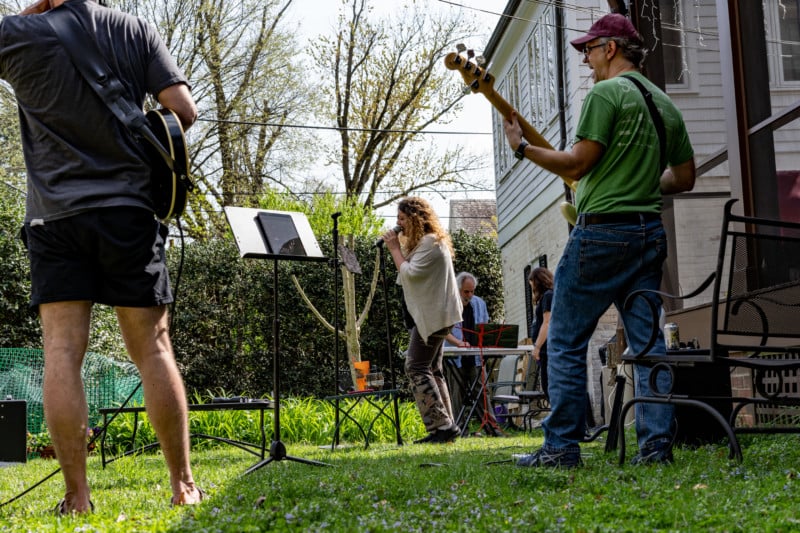 Day 83: Karen Harris (center), her husband Doug (right) play music in their backyard with their neighbors. The group of musicians in the AU Park neighborhood has gathered occasionally during the pandemic to play music outside.
Day 83: Karen Harris (center), her husband Doug (right) play music in their backyard with their neighbors. The group of musicians in the AU Park neighborhood has gathered occasionally during the pandemic to play music outside. 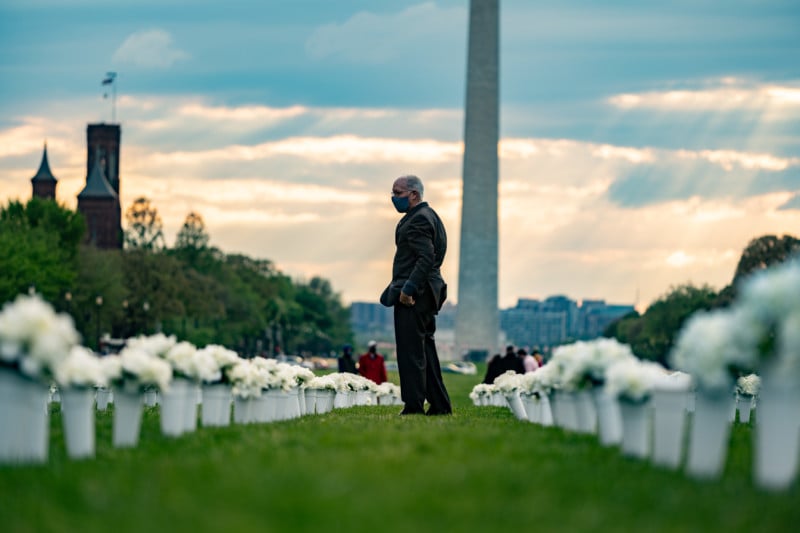 Day 86: Congressman Bill Foster walks through the Gun Violence Memorial on the National Mall. 40,000 flowers were placed on Mall to memorialize the victims of gun violence in the country each year. The memorial was implement by Giffords, a group led by Gabby Giffords, the former Arizona representative who was shot in the head at an event in her home state in 2011.
Day 86: Congressman Bill Foster walks through the Gun Violence Memorial on the National Mall. 40,000 flowers were placed on Mall to memorialize the victims of gun violence in the country each year. The memorial was implement by Giffords, a group led by Gabby Giffords, the former Arizona representative who was shot in the head at an event in her home state in 2011. 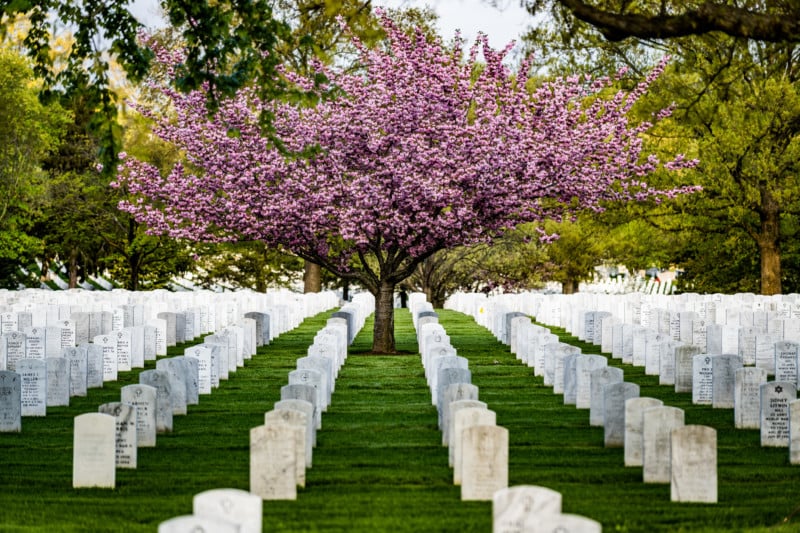 Day 87: Section 60 of Arlington Cemetery in Arlington, Virginia where many of those killed in the wars in Afghanistan and Iraq are buried. President Joe Biden announced it was “time to end” the war in Afghanistan, planning to fully withdraw troops by September 11, 2021.
Day 87: Section 60 of Arlington Cemetery in Arlington, Virginia where many of those killed in the wars in Afghanistan and Iraq are buried. President Joe Biden announced it was “time to end” the war in Afghanistan, planning to fully withdraw troops by September 11, 2021. 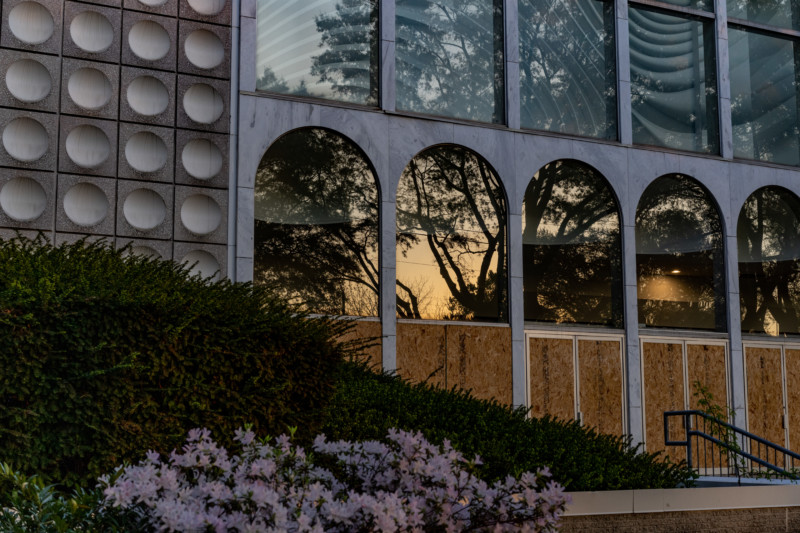 Day 90: A closed Lord & Taylor clothing store in the Friendship Heights neighborhood of Washington, DC. The department store announced it was closing all of its stores in August of 2020 after declaring bankruptcy.
Day 90: A closed Lord & Taylor clothing store in the Friendship Heights neighborhood of Washington, DC. The department store announced it was closing all of its stores in August of 2020 after declaring bankruptcy.  Day 92: A man holds a sign in Black Lives Matter Plaza following the announcement that a jury convicted former police officer Derek Chauvin for the killing of George Floyd.
Day 92: A man holds a sign in Black Lives Matter Plaza following the announcement that a jury convicted former police officer Derek Chauvin for the killing of George Floyd. 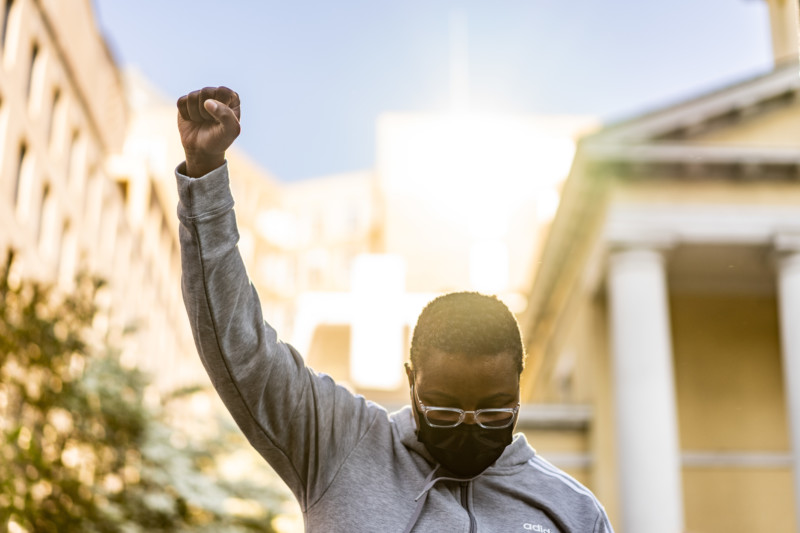 Day 92: Cheria Askew celebrates at Black Lives Matter Plaza after a jury convicted former police officer Derek Chauvin for the killing of George Floyd.
Day 92: Cheria Askew celebrates at Black Lives Matter Plaza after a jury convicted former police officer Derek Chauvin for the killing of George Floyd.  Day 93: A nighttime exposure of a cherry blossom tree at the Tidal Basin on Earth Day. This area of the Tidal Basin regularly floods due to a combination of rising waters from climate change and the land slowly sinking into the water. Many cherry trees have died after exposure to the brackish water. Today, President Biden pledged to cut US greenhouse gas pollution by 50% by the year 2030.
Day 93: A nighttime exposure of a cherry blossom tree at the Tidal Basin on Earth Day. This area of the Tidal Basin regularly floods due to a combination of rising waters from climate change and the land slowly sinking into the water. Many cherry trees have died after exposure to the brackish water. Today, President Biden pledged to cut US greenhouse gas pollution by 50% by the year 2030. 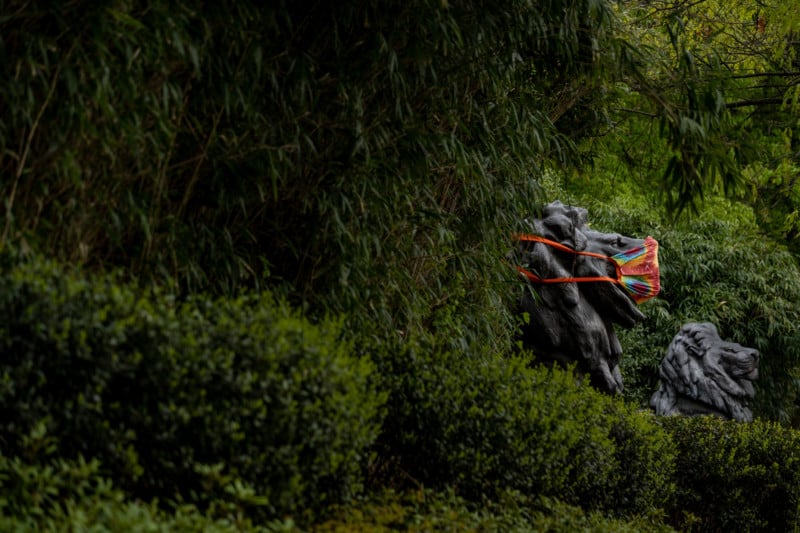 Day 94: One of the lion statues outside of the National Zoo has a facemask. Today, the Smithsonian Institution announced that they would begin opening their museums, starting with the Udvar-Hazy Center opening on early May.
Day 94: One of the lion statues outside of the National Zoo has a facemask. Today, the Smithsonian Institution announced that they would begin opening their museums, starting with the Udvar-Hazy Center opening on early May.
For weeks, I’d been thinking about what day 100 should look like. It had to be something with a near 100% chance of success -- I wouldn’t get another crack at it. I was looking for a photo that would both summarize and be worthy of my last day on this project. I decided instead of one photo, I would take (checks notes) 1,230.
Just like on day one, I got up well before dawn and loaded up a phalanx of gear. I drove down to a spot I had previously scouted a few days before, a statue in a traffic circle on 16th street that gave me an elevated straight-on view of the White House. I would photograph two timelapses (one serving as a backup) as the sun rose. At 4:45 AM, the cameras took the first photos.
Four hours later, the sunlight hit the White House’s iconic white columns and I was done. I rushed home to process the images and edit the timelapse. I sent the final video to the amazing team at Politico that had been building out the site over the past few months. A few hours later, the site went live.
 Day 94: One of the lion statues outside of the National Zoo has a facemask. Today, the Smithsonian Institution announced that they would begin opening their museums, starting with the Udvar-Hazy Center opening on early May.
Day 94: One of the lion statues outside of the National Zoo has a facemask. Today, the Smithsonian Institution announced that they would begin opening their museums, starting with the Udvar-Hazy Center opening on early May. 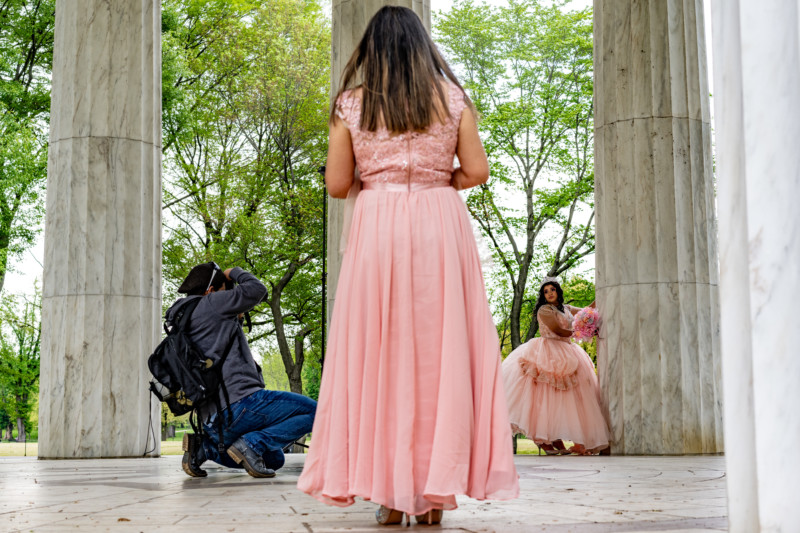 Day 95: Ashley Ramirez, 14, of Culpeper, Virginia takes photographs for her quinceañera as her mother looks on at the District of Columbia World War I memorial.
Day 95: Ashley Ramirez, 14, of Culpeper, Virginia takes photographs for her quinceañera as her mother looks on at the District of Columbia World War I memorial. 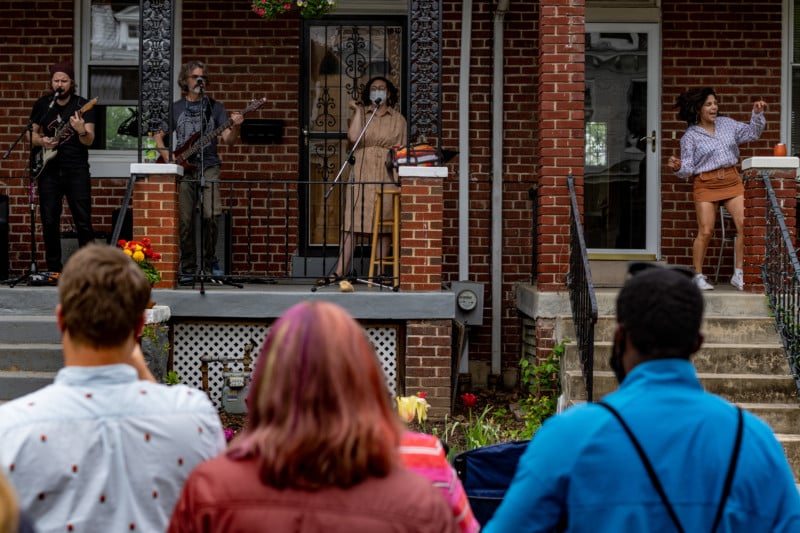 Day 95: The band Sligo Waterdogs plays at the first annual Petworth Porchfest. The music festival showcased local musicians playing on porches around the Petworth neighborhood.
Day 95: The band Sligo Waterdogs plays at the first annual Petworth Porchfest. The music festival showcased local musicians playing on porches around the Petworth neighborhood.
Looking back, the best part of this project was the routine I’d developed of photographing day after day. While I won’t miss being glued to my Twitter feed, I did love the challenge of making an interesting image on days when there wasn’t an obvious news event to cover. I spent time in every ward in the city and had long conversations with people who (like myself) seemed eager to connect to another person after the isolation of the last year. I saw the economic devastation suffered by local businesses but also the inventiveness of those who were able to adapt, like a hairstylist who now made house calls after his salon closed. The work of photography often feels like a gift, an opportunity to be curious and look deeper and to do the work, day in and day out.
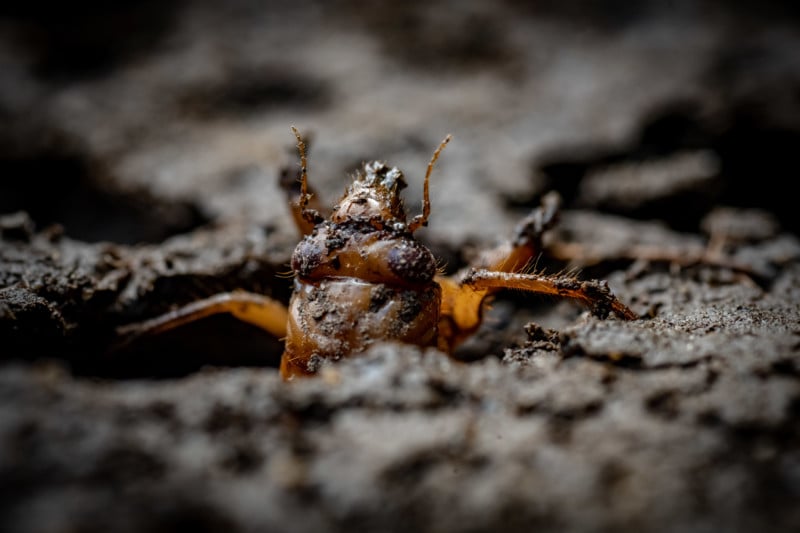 Day 97: Brood X cicadas emerge from the ground in Washington, DC after seventeen years underground.
Day 97: Brood X cicadas emerge from the ground in Washington, DC after seventeen years underground. 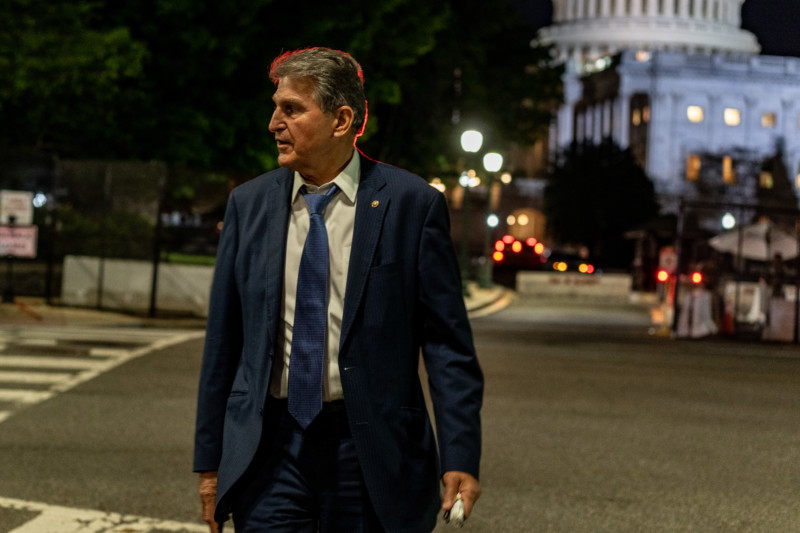 Day 99: Senator Joe Manchin leaves the Capitol grounds as President Joe Biden addresses a joint session of Congress.
Day 99: Senator Joe Manchin leaves the Capitol grounds as President Joe Biden addresses a joint session of Congress. 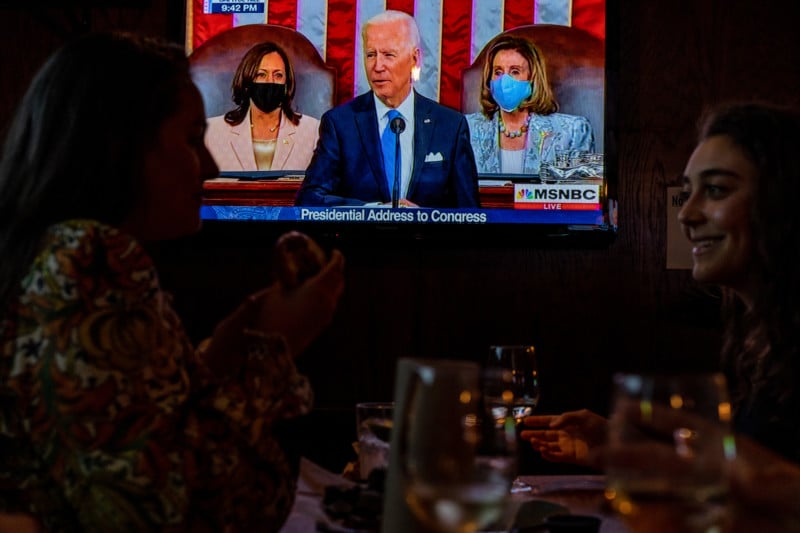 Day 99: People cheer while watching as President Joe Biden addresses a joint session of Congress, from the Union Pub near the US Capitol.
Day 99: People cheer while watching as President Joe Biden addresses a joint session of Congress, from the Union Pub near the US Capitol.
Header image: Day 1 -- President-elect Joseph R. Biden takes the oath of office as First Lady-elect Jill Biden looks on during the 59th presidential inauguration in Washington, DC, on Wednesday, January 20, 2021.
_About the author: Stephen Voss is a photographer based in Washington, DC. He grew up in New Jersey and lives with his family in DC where he covers those in power and those seeking to be so. His clients include TIME, Politico, AARP, Salesforce, and Audi. His work is in the permanent collection of the Library of Congress. He has an abiding love of bonsai trees, gardening, and going for nighttime runs.
His work can be found on his website. He writes about photography on Light Readings, and can be found on Instagram and Twitter._







#editorial #inspiration #longform #essay #first100days #joebiden #journalism #photoessay #photojournalism #politico #politics #stephenvoss #unitedstatespolitics
